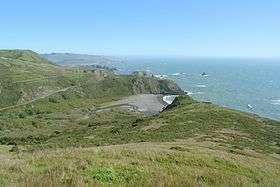California coastal prairie

California coastal prairie, also known as northern coastal grassland, is a grassland plant community of California and Oregon in the temperate grasslands, savannas, and shrublands biome. It is found along the Pacific Coast, from as far south as Los Angeles in Southern California up into southern Oregon.
Description
California's coastal prairies are the most species-rich grassland types in North America (Stromberg et al. 2002). Coastal prairie is also the single most urbanized major vegetation type in the U.S.; 24 percent of the habitat has been lost to pavement.[1]
Wind, salt spray, fire, and grazing are evolutionary disturbances which affected shrubs and tree growth maintaining more open grasslands. In the absence of grazing and/or fire, many areas of coastal prairie are being lost to shrub and tree encroachment.[2] The accumulated organic matter from centuries produce a rich, dark prairie soil (mollisol). Coastal prairie often forms a landscape mosaic with the Northern coastal scrub plant community.
Characteristic species
Characteristic species of this community include:[3]
- Perennial bunch grasses:
- Other plants
- Bracken fern - Pteridium aquilinum
- Douglas iris - Iris douglasiana
- Blue dicks - Dichelostemma capitatum
- Blue-eyed grass - Sisyrinchium bellum
Endangered species
Many of the rarest plant species in the coastal prairie exist mainly on land currently being grazed by livestock; these species have been disappearing when land is set aside for conservation and the livestock are removed.[4]
Rare and endangered species found in the coastal prairie include:
- Flora
- Santa Cruz tarweed - Holocarpha macradenia — found in limited locations
- San Francisco popcornflower - Plagiobothrys diffusus
- Robust spineflower - Chorizanthe robusta robusta
- Artist's popcornflower - Plagiobothrys chorisianus
- Pt. Reyes meadowfoam - Limnanthes sp.
- Santa Cruz clover - Trifolium buckwestiorum
- Indian clover - Trifolium amoenum
- Gray's clover - Trifolium grayii
- San Francisco owl's clover - Triphysaria floribunda.
- Fauna
- Ohlone tiger beetle - Cicindela ohlone — endemic to Santa Cruz County
- San Francisco garter snake - Thamnophis sirtalis tetrataenia
Endangered habitat
Unlike many other Mediterranean climate grasslands, the mostly perennial bunch grasses stay green all summer, which makes the coastal prairies attractive for grazing cattle and sheep. Other effects to this plant community include agriculture and development. California's coastal prairie, like most other California grasslands, has been greatly affected by the invasion of non-native species, including earthworms, snails, slugs, pill bugs, earwigs, and annual Mediterranean grasses.
Most recently, invasive perennial grasses (see invasive grasses of North America) are the greatest threat. These include velvet grass (Holcus lanatus), tall fescue (Festuca arundinacea), and Harding grass (Phalaris aquatica); the impact of these species can be somewhat ameliorated by well-planned livestock grazing, which can reduce these species' cover and allow native species to persist.
Regulatory context
California's coastal prairies are protected by the California Coastal Act, which considers these habitat types to be Environmentally Sensitive Habitat Areas (ESHA). Akin to the endangered species act for habitat types on California's coast, ESHA protections disallow any harm to so designated habitats, except where such harm is necessary to otherwise restore the habitat as a whole (e.g., prescribed fire, grazing).
See also
- Native grasses of California
- Grasslands of California
- Bunch grass
- Invasive grasses of North America
- Invasive species
References
Bibliography
- Ornduff, Robert. (2003) Introduction to California Plant Life. Revised by Phyllis M. Faber and Todd Keeler-Wolf. University of California Press.
- Plant Communities of Santa Cruz County, Santa Cruz Chapter, California Native Plant Society.
- Hayes, G., and K. D. Holl. 2003. Cattle grazing impacts on annual forbs and vegetation composition of mesic grasslands in California. Conservation Biology 17:1694 - 1702.
- Stromberg, M. R., P. Kephart, and V. Yadon. 2002. Composition, invasability, and diversity in coastal California grasslands. Madroño 48:236-252.
- Loveland, T. R., and H. L. Hutcheson. 1995. Monitoring Changes in Landscapes from Satellite Imagery. Pages 468-473 in U. S. G. Society, editor. Our Living Resources: A Report to the Nation on the Distribution, Abundance, and Health of U.S. Plants, Animals, and Ecosystems. U.S. Department of Interior, National Biological Service, Washington, D.C.
- Ford, L. D., and G. F. Hayes. 2007. Northern coastal scrub and coastal prairie. in M. G. Barbour, T. Keeler-Wolf, and A. A. Schoenherr, editors. Terrestrial vegetation of California. University of California Press., Berkeley.
Notes
External links
- CNGA: California Native Grasslands Association website
- CNGA: Guide to Visiting California's Grasslands
- CNGA: Bunchgrass species & habitats preservation & restoration